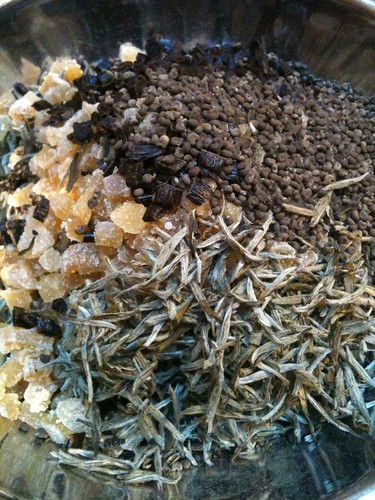Zangvil Tea in the Making

Mission accomplished!
Zangvil tea was launched on Sunday, at long last... That was quite a journey discovering white tea and perfecting the tea formula (the first version of which I served at the Spring Welcoming Tea Ceremony during my Hanami Tea Party in March 2009).
The tea turned out beautiful if I may say so myself, and I'm absolutely smitten with the new label design, as well as the clean looking tea tins (they are all white!). Tea is an experience that incorporates all the senses - the sound of the water simmering and pouring, the look of the leaf (dry and infused), the colour of the liquor, the scent emanating from the dry and infused leaf and, of course, from the cup of tea itself - and last but not least - the taste and the texture of the tea in the mouth.

Last week, I made the 1st batch of Zangvil tea - only 8 tins to be exact. It was a fun yet not easy at all task, the toughest part was certainly slicing the vanilla beans. Even the candied ginger had to be minced into smaller cubes for best infusion results. Below you can see all the components of the tea after weighing but before being blended and packaged.

Zangvil tea is made of silver needle white tea perfumed with jasmine flowers (you'll find some petal bits and pieces scattered around), crystallized ginger, vanilla bean and ambrette seeds. It produces a very light, clear liquor (only slightly yellow) with shimmering silver plume floating in the water in the first 2-4 steepings, which gives it a very subtle and pretty effect. To fully enjoy that, serve in clear or white tea cups only!
It can (and should!) be infused up to 7 times to fully experience its subtle comlexity and richness. The floral jasmine and peachy white tea notes are most prominent in the first 3 infusions. After that, the ginger and vanilla and ambrette seed linger on. The latter linger all the way into the 7th steeping, with subtly balsamic, nutty aroma with a hint of sweetness and very smooth mouthfeel.
It is best served on its own, and should be sipped when its slightly cooled off. A pure treat on its own, but also wonderful when served with small, nutty desserts such as halva, almond pastries, white chocolate, and poached pear (for more serving ideas, see my Zangvil tea party menu).
Each tea tin costs $30, and contains 50gr of Zangvil tea blend; which should get you at least through 25 tea parties of your own. And if you were to take full advantage of the re-steeping potential, you will get at least 175 cups of tea out of this tin. That's a lot of tea!
Labels: Zangvil Tea



0 Comments:
Post a Comment
<< Home